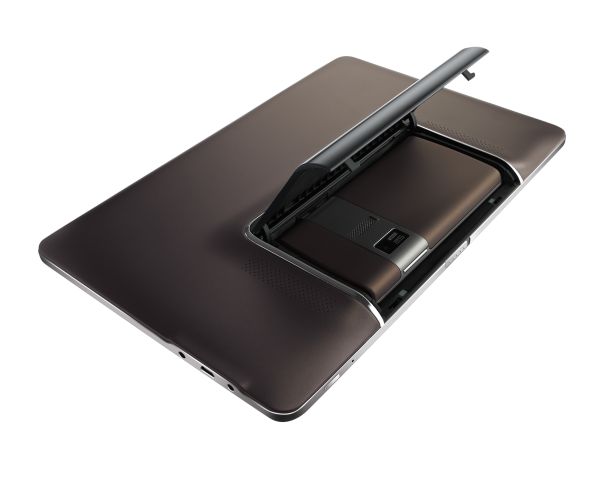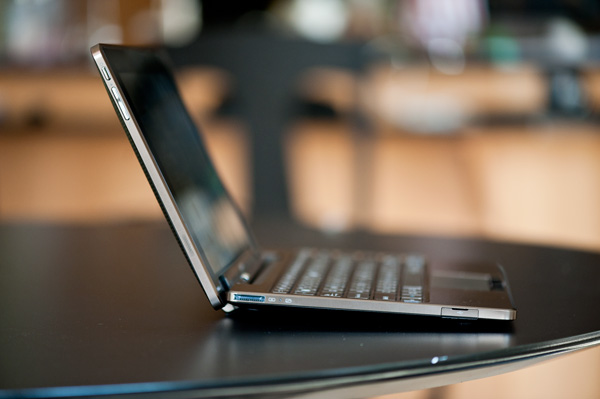The Ultrabook: Meet the New Thin and Light Intel Notebook
by Anand Lal Shimpi on May 31, 2011 12:01 AM EST- Posted in
- Laptops
- CPUs
- Intel
- Atom
- Haswell
- Computex 2011
- Trade Shows
- Ultrabook
Convergence and the Changing PC Landscape
It's too cliché to proclaim netbooks are dead. Perhaps the appropriate phrase is netbooks are no longer interesting to write about, but they do have a roadmap going forward. For years we heard about convergence in the PC and consumer electronics space. Our TVs, set top boxes and video players were all supposed to get more intelligent. Last year we saw the first real fruits of those efforts with the introduction of Google TV and devices like the Boxee Box. Convergence has finally reached mainstream, but the process isn't over yet.
The smartphone revolution is the beginning of a much larger convergence. A melding of computing devices, convergence between the smartphone and tablet, or the tablet and notebook PC. As is typically the case of any convergence process, this one doesn't have a clear end nor does it have a clear roadmap. Along the way there will be many attempts and likely more failures than successes until we meet the handful of devices and strategies that really make sense.
The smartphone will become even more PC-like and the tablet will become even more notebook-like. But where does that leave PCs? They too must evolve and play their role in this process of convergence, after all it will be PC technologies that ultimately drive the convergence (from the example earlier, is it any surprise that both Google TV and Boxee Box feature very PC-like processors running Linux based OSes?).
How does the PC evolve? Part of it is a change in software. Traditional desktop OSes won't go away, but they must incorporate the advantages and innovations brought by the players in the smartphone/tablet markets. Apple is at the forefront of much of this revolution and the next version of Mac OS X already starts to look more like iOS with its app store, app launcher and iOS-like full screen modes. Microsoft is rumored to be preparing a very tablet friendly UI that will layer upon Windows 8, which itself will span everything from tablets (and smartphones?) to desktops.
As we've learned in the past, software enables hardware and hardware enables software. The PC's changing role in the future also requires some new thought about hardware design and what sort of decisions microprocessor manufacturers are going to make going forward. We've already seen hints of this from both AMD and Intel. The two companies no longer make discrete CPUs but rather complete SoCs, similar to what you'd find in a smartphone just on a much larger scale. Like I said before, the PC will adopt the learnings of the smartphone and tablet industries as it evolves.
Today Intel is announcing the first step in that evolution, an announcement that we actually first heard about from another company a year ago.
When Apple introduced the 2010 MacBook Air, Steve Jobs called it a preview of the future of the MacBook lineup. The subsequent MacBook Pro release looked pretty traditional so the messaging may have been a bit premature. I believe what Jobs was referring to was the move toward thinner, lighter and SSD based notebooks across the board. Intel's announcement today puts that future on a roadmap, and the device is called the Ultrabook.













33 Comments
View All Comments
StormyParis - Tuesday, May 31, 2011 - link
Intel has a history of failing at anything where they don't have a huge headstart (ie, anything non x86, or non purely process driven: Itanium, networks, wireless, DGX, RISC... basically, anything non Flash and non x86, and even x86 they managed to mess up a few times.They finally threw in the diversification towel and went all-in on x86. I'm very unclear about what advantages x86 has apart from Intel's fabs. MS dramatically dropping the ball in the phone/tablet space didn't help them at all. MS trying to avoid a catastrophe by going ARM doesn't either. Even if MS finally manages to put together something believable in the phone/tablet space, it won't be an Intel exclusive.
My new Desktop is a $350 E-350, and is plenty powerful for what I do with it. I'm guessing next year ARM will be at that level of power (basically, playing videos on one screen, office stuff on the other, very light gaming), and it will be a good time to take a long hard look at whether paying $150+ for a Windows license really makes sense.
I think the weak link int the ARM food chain is Linux: no games, too fragmented, too experimental still, bad documentation. If a good strong and above newb-friendly version of Linux could emerge as a good all-rounder, ARM's chances would be even better. If the Linux camp doesn't wake up quickly, we'll end up with Windows on ARM, which will be... sad.
JarredWalton - Tuesday, May 31, 2011 - link
Generally speaking, all modern CPUs are now RISC, but the x86 processors have an x86 decoding front end that translates the CISC instructions into RISC. Intel did this first way back in the P6 days. Of course, we also have all the SSE, MME, and other extensions (not just from Intel -- all the other CPUs have specialized instruction sets as well for certain work), so I'm not sure how valid calling anything "RISC" is these days.I'd also take pretty strong exception with the assertion that Intel has "failed" at networks and wireless; my experience is that both their WiFi and NIC solutions are slightly better than the competition.
Then we get to the part where you say that an E-350 desktop is "plenty powerful for what you do". I suppose that's great for you, but having used E-350 and a lot of other systems, E-350 would be way down my list for a desktop system. I might use if for an HTPC, but anything more demanding than that and there are far better options. Llano at least is looking pretty good in initial testing, though.
Wilco1 - Tuesday, May 31, 2011 - link
CISC CPUs are NOT RISC, as this is about the instruction set. And they are not the same internally either. CISCs always carry the extra overhead of complex variable length instruction decoders, large micro code ROMs and micro sequencers, extra logic to deal with read/modify/write instructions etc.It is for this reason that you can have an Out-of-order RISC (Cortex-A9) which is not only several times smaller than an Atom, but also much faster while using far less power. That's the difference between RISC and CISC.
Penti - Tuesday, May 31, 2011 - link
There's plenty of documentation, games and coherency in GNU/Linux but it is largely so in the embedded and mobile space as ARM doesn't target desktops.So a GNU/Linux platform with Gstreamer (Gstreamer and OpenMAX decoders), PulseAudio, GCC toolchain, libraries or middleware such as Clutter, Qt, Android and EGL/DRI/OpenGL ES support does plenty well in the phone, tablet and embedded market with multimedia, applications, user friendliness and games. You have players such as MeeGo, WebOS, Android and low-level infrastructure oriented LiMo. What you don't have and never will have is a consumer GNU/Linux distro that will run on everything from desktop oriented netbooks, desktops and server to phones and tablets. But you already has great games for the GNU/Linux platforms through the mobile-variants. There's no reason you can't use the same tools and API's for full size aka desktop games. For that matter Microsoft will never run Windows (NT) on phones. 8 for ARM I'm sure won't be for desktop users and I'm even more sure you won't be able to install it yourself. Intel however was rather set on running GNU/Linux on x86 tablets and smartphones. That might change now when their partner Nokia decided to go with Microsoft and downsize a profitable company, but I'm pretty sure they don't base their business on that. Different platforms should exist just fine tomorrow too. It's the normal consumers and hardware manufacturers that decides if Windows 8 tablets/smartbooks stick. Just being Windows based and building on ribbon won't do it by it self.
Freddo - Tuesday, May 31, 2011 - link
Looking forward to the fanless Cedar Trail netbooks a lot.I hope there will be at least one "quality" model that is released with metal, instead of just feeling like a cheap plastic toy. Oh, and support for HDMI, of course.
SteelCity1981 - Tuesday, May 31, 2011 - link
"Silvermont to look like? I'd say it might look a lot like a modern, ultra low power take on Conroe."So that will mean by 2019 the Atoms should have similar performace as the first gen Core I series. :)
soydeedo - Tuesday, May 31, 2011 - link
Does anyone know the model of the laptop in the second picture on the very first page of the article? The picture below the new Padfone.stonedatheist - Tuesday, May 31, 2011 - link
Yes I do, seeing as how I just ordered one :) it's the Asus Transformer inserted into its keyboard dock.soydeedo - Tuesday, May 31, 2011 - link
Thanks a lot for the help, and enjoy your new toy. =)Very sleek indeed. ASUS isn't playing around these days.
Kepe - Tuesday, May 31, 2011 - link
Yep, the URL to the picture is http://images.anandtech.com/reviews/tablets/ASUS/E... so it isn't that hard to guess what it is ;)